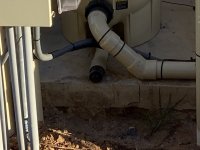Hi so I have a Pentair Clean and Clear cartridge filter that has a 1-1/2” drain plug at the bottom. I would like to not discharge all that saltwater in the area of the filter. Ideally I would like to convert the 1-1/2 inch plug into a drain line. I am therefore looking for an 1-1/2 inch O-ring male with either an elbow or threaded hole to put an elbow in. Then I can run a drain line with a ball valve.
Doing this would then allow me to rotate the filter since I would not have to have easy access to the drain plug in front.
Here’s what I am currently setting up.
Doing this would then allow me to rotate the filter since I would not have to have easy access to the drain plug in front.
Here’s what I am currently setting up.

Last edited by a moderator:



